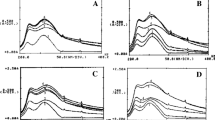Abstract
This study examined the antibacterial mode of action of low molecular weight water-soluble chitosan (LMWSC; MW1, MW3, MW5 and MW10) using a combination of approaches, including antibacterial assays, culture in media with different pH values, bactericidal kinetics, cellular leakage measurements, depolarization, and electron microscopy, as well as an in vivo study utilizing a wound infection and wound healing model. The antibacterial activity of LMWSC was related inversely to pH, with higher activities being observed at lower pH values. In addition, evaluation of the effect of bactericidal concentrations of LMWSC on the morphology of Bacillus megaterium and Escherichia coli O–157 revealed that it induces filamentation. Furthermore, the degree of depolarization (in Escherichia coli, pH 7.4) and calcein leakage (lipid composition; L-α-phosphatidylethanolamine (PE)/L-α-phosphatidyl-dl-glycerol (PG)=7/3 (w/w), pH 5.4 and 7.4) were evaluated. Moreover, cells cultured at various pHs were evaluated by confocal microscopy (pH 5.4 and 7.4). These results showed that treatment with LMWSC with different molecular weights had different effects on bacteria. In particular, LMWSC (MW10) cause more visible damage to the bacterial cell membrane than lower molecular weight LMWSC, which is due most likely to the penetration of cells by the lower weight molecules. Interestingly, MW5 was found to attack the membrane and penetrate the cells. In addition, scanning electron microscopy showed that MW10 caused significant morphological changes to the surface of the bacteria. Finally, an in vivo study utilizing a wound infection or healing model showed that LMWSC had the potential for use as a lead compound for the development of a novel anti-infective or healing compound.
Similar content being viewed by others
References
D. Raafat, K. von Bargen, A. Haas, and H. G. Sahl, Appl. Environ. Microbiol., 74, 3764 (2008).
M. T. Tosteson, S. J. Holmes, M. Razin, and D. C. Tosteson, J. Membr. Biol., 87, 35 (1985).
Y. J. Jeon and S. K. Kim, J. Chitin Chitosan, 6, 163 (2001).
P. J. Park, J. Y. Je, H. G. Byun, S. H. Moon, and S. K. Kim, J. Microbiol. Biotechnol., 14, 317 (2004).
P. J. Park, J. Y. Je, and S. K. Kim, Carbohydr. Polym., 55, 17 (2004).
C. Porporatto, I. D. Bianco, C. M. Riera, and S. G. Correa, Biochem. Biophys. Res. Commun., 304, 266 (2003).
Y. Maezaki, K. Tsuji, Y. Nakagawa, Y. Kawai, M. Akimoto, T. Tsugita, W. Takekawa, A. Terada, H. Hara, and T. Mitsuoka, Biosci. Biotechnol. Biochem., 57, 1439 (1993).
J. W. Nah and M. K. Jang, J. Polym. Sci. Part A: Polym. Chem., 40, 3796 (2002).
T. H. Kim, I. K. Park, J. W. Nah, Y. J. Choi, and C. S. Cho, Biomaterials, 25, 3783 (2004).
M. K. Jang, Y. I. Jeong, and J. W. Nah, Colloids Surf. B: Biointerf., 81, 530 (2010).
Y. Park, M. H. Kim, S. C. Park, H. Cheong, M. K. Jang, J. W. Nah, and K. S. Hahm, J. Microbiol. Biotechnol., 18, 1729 (2008).
J. Rhoades and S. Roller, Microbiol., 66, 80 (2002).
Y. Park, S. N. Park, S.-C. Park, J. Y. Park, Y. H. Park, J. S. Hahm, and K.-S. Hahm, Biochem. Biophys. Res. Commun., 321, 631 (2004).
K. Matsuzaki, K. Sugishita, and K. Miyajima, FEBS Lett., 449, 221 (1999).
Y. Pouny, D. Rapaport, A. Mor, P. Nicolas, and Y. Shai, Biochemistry, 31, 12416 (1992).
Y. Park, S. N. Park, S.-C. Park, S. O. Shin, and K.-S. Hahm, Biochim. Biophys. Acta, 1764, 24 (2006).
S. A. Kristian, A. M. Timmer, G. Y. Liu, X. Lauth, N. Sal-Man, Y. Rosenfeld, Y. Shai, R. L. Gallo, and V. Nizet, FASEB J., 21, 1107 (2007).
D. G. Lee, H. N. Kim, Y. Park, H. K. Kim, B. H. Choi, C. H. Choi, and K.-S. Hahm, Biochim. Biophys. Acta, 1598, 185 (2002).
J. Lutkenhaus, Trends Genet., 6, 22 (1990).
X. F. Liu, Y. L. Guan, D. Z. Yang, Z. Li, and K. D. Yao, J. Appl. Polym. Sci., 79, 1324 (2001).
J. A. Op den Kamp, Annu. Rev. Biochem., 48, 47 (1979).
J. C. Fernandes, P. Eaton, A. M. Gomes, M. E. Pintado, and M. F. Xavier, Ultramicroscopy, 109, 854 (2009).
J. C. M. Stewart, Anal. Biochem., 104, 10 (1980).
Author information
Authors and Affiliations
Corresponding authors
Rights and permissions
About this article
Cite this article
Park, SC., Nah, JW. & Park, Y. pH-dependent mode of antibacterial actions of low molecular weight water-soluble chitosan (LMWSC) against various pathogens. Macromol. Res. 19, 853–860 (2011). https://doi.org/10.1007/s13233-011-0812-1
Received:
Revised:
Accepted:
Published:
Issue Date:
DOI: https://doi.org/10.1007/s13233-011-0812-1




